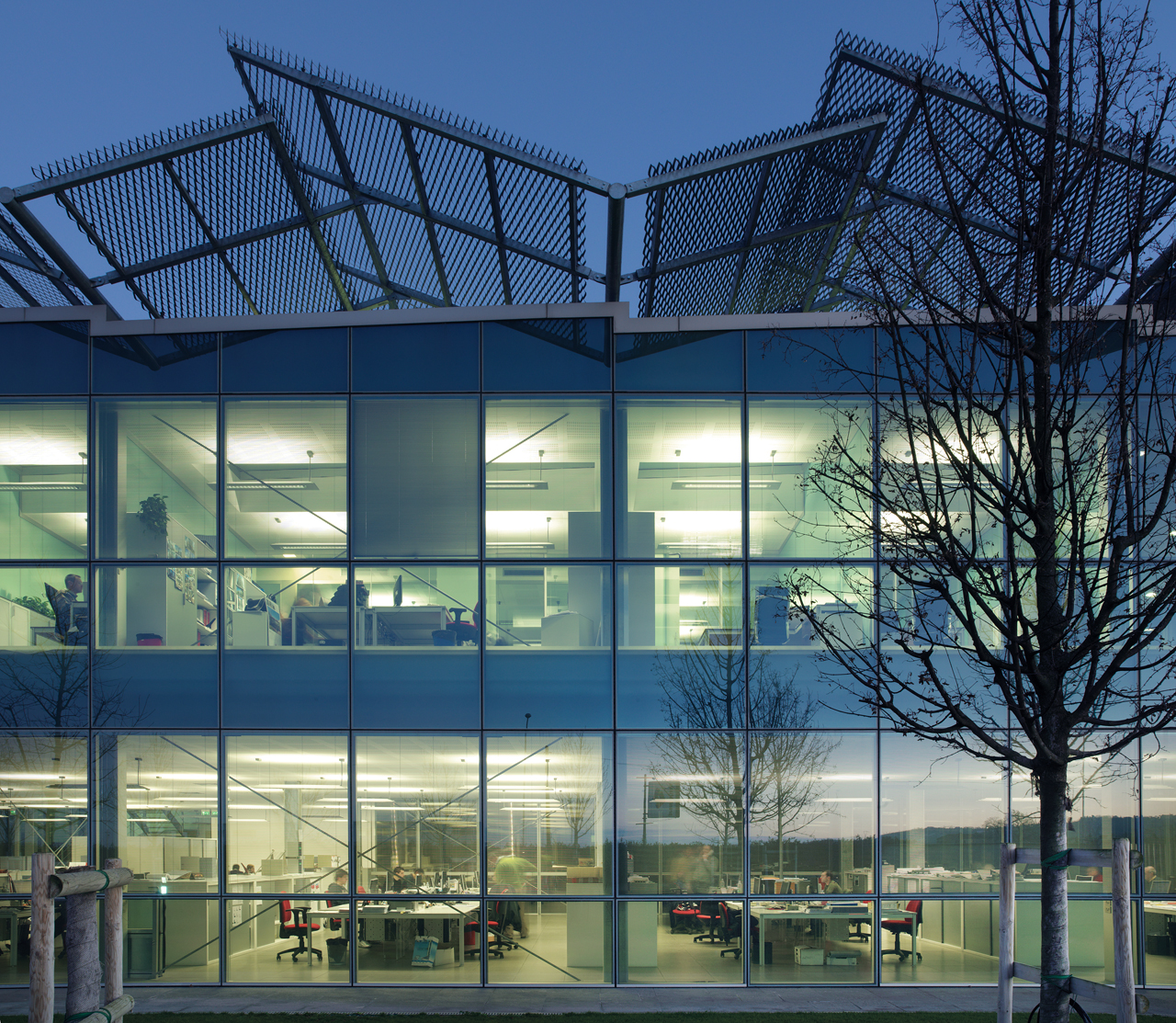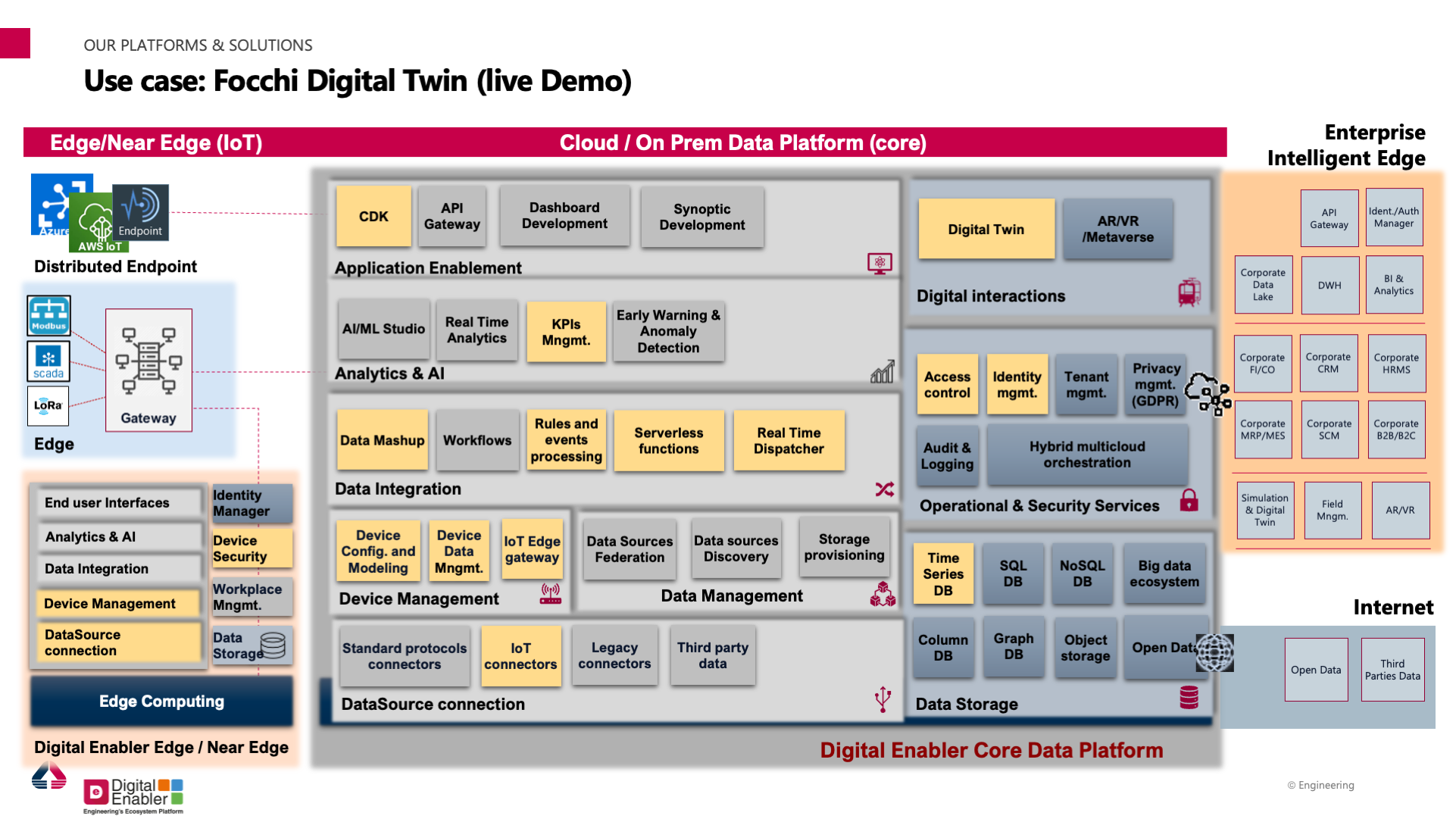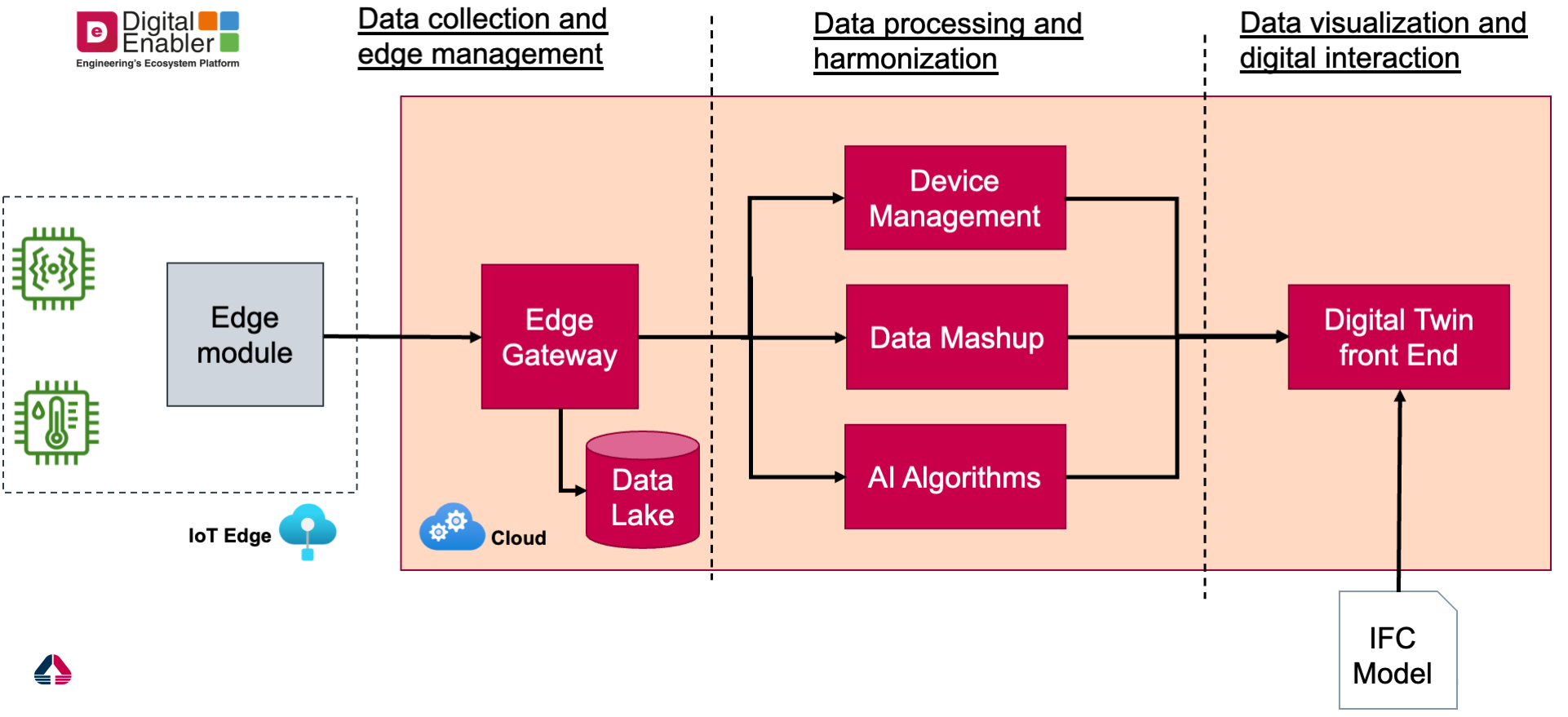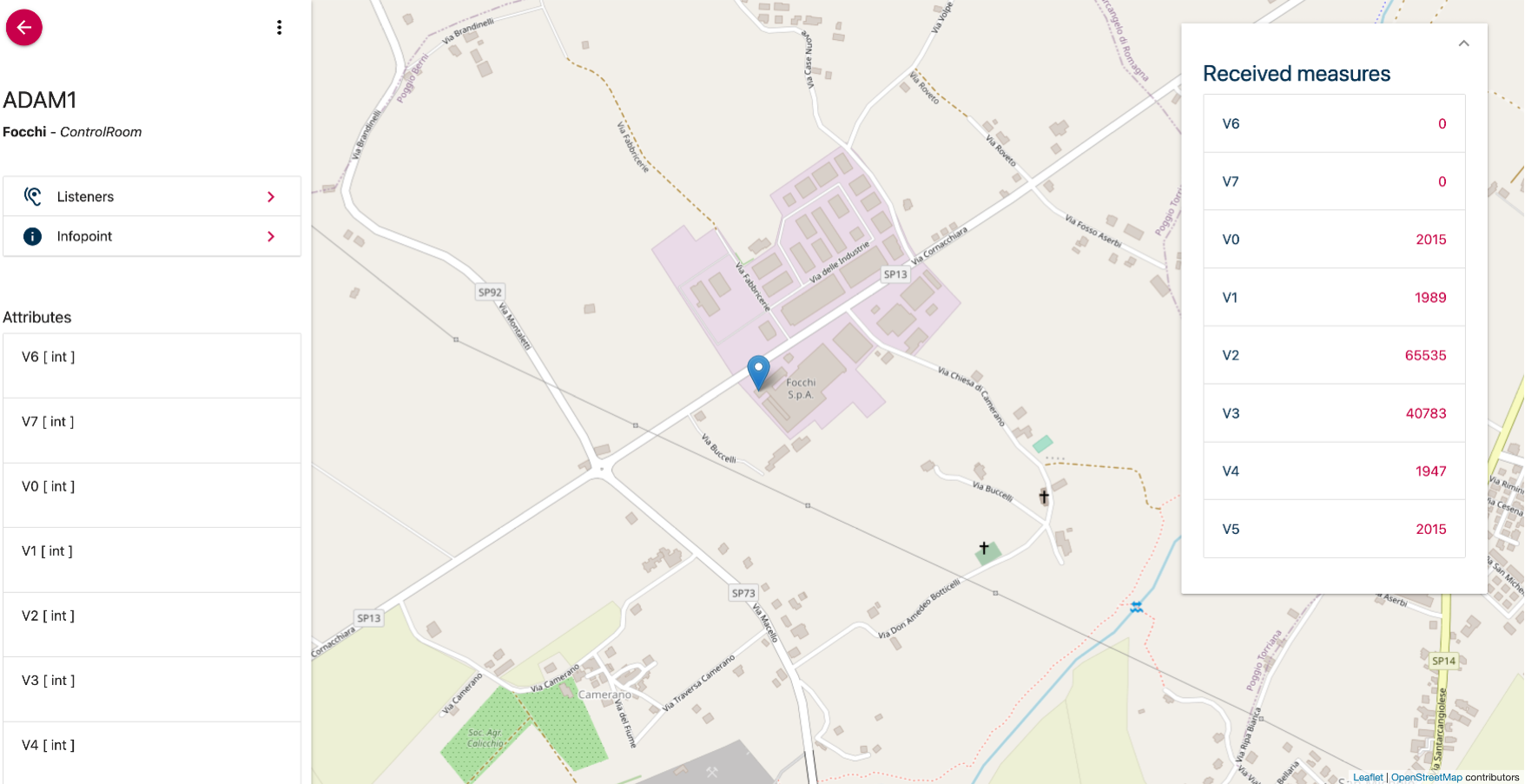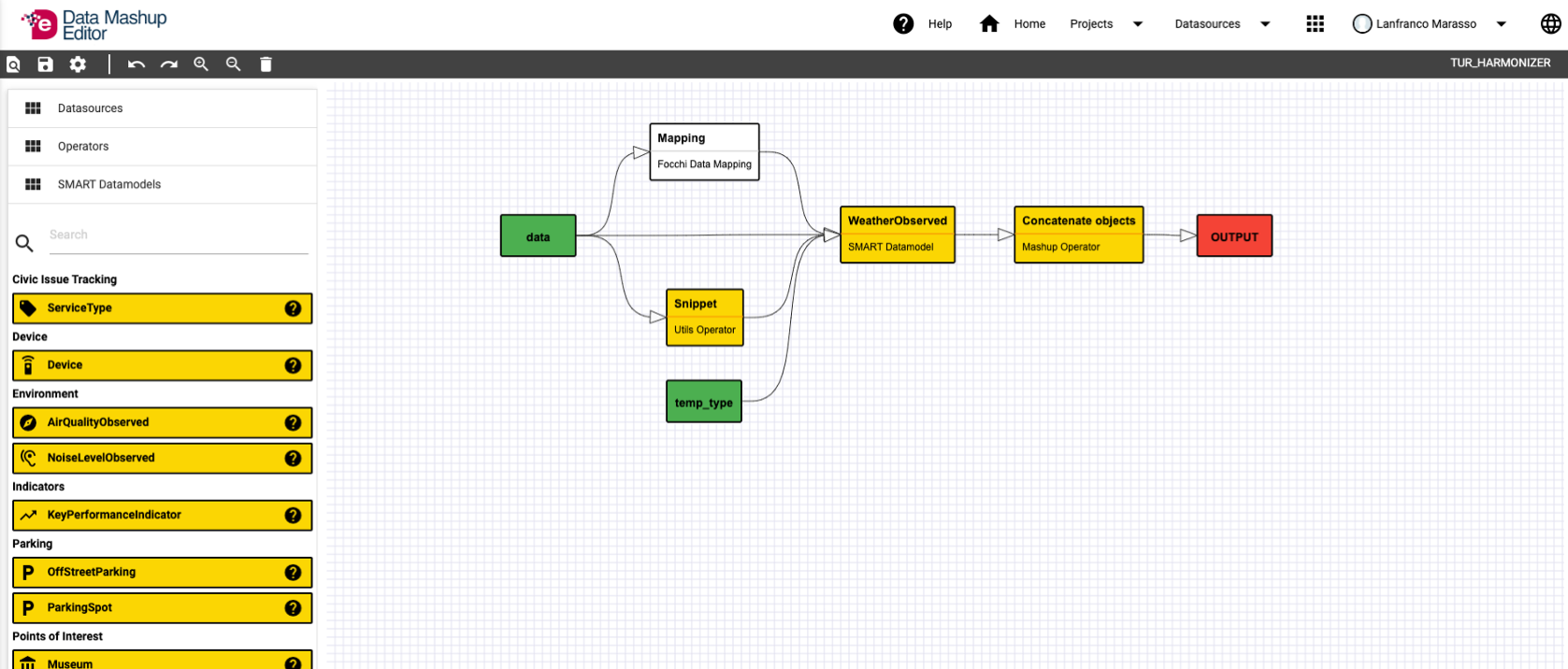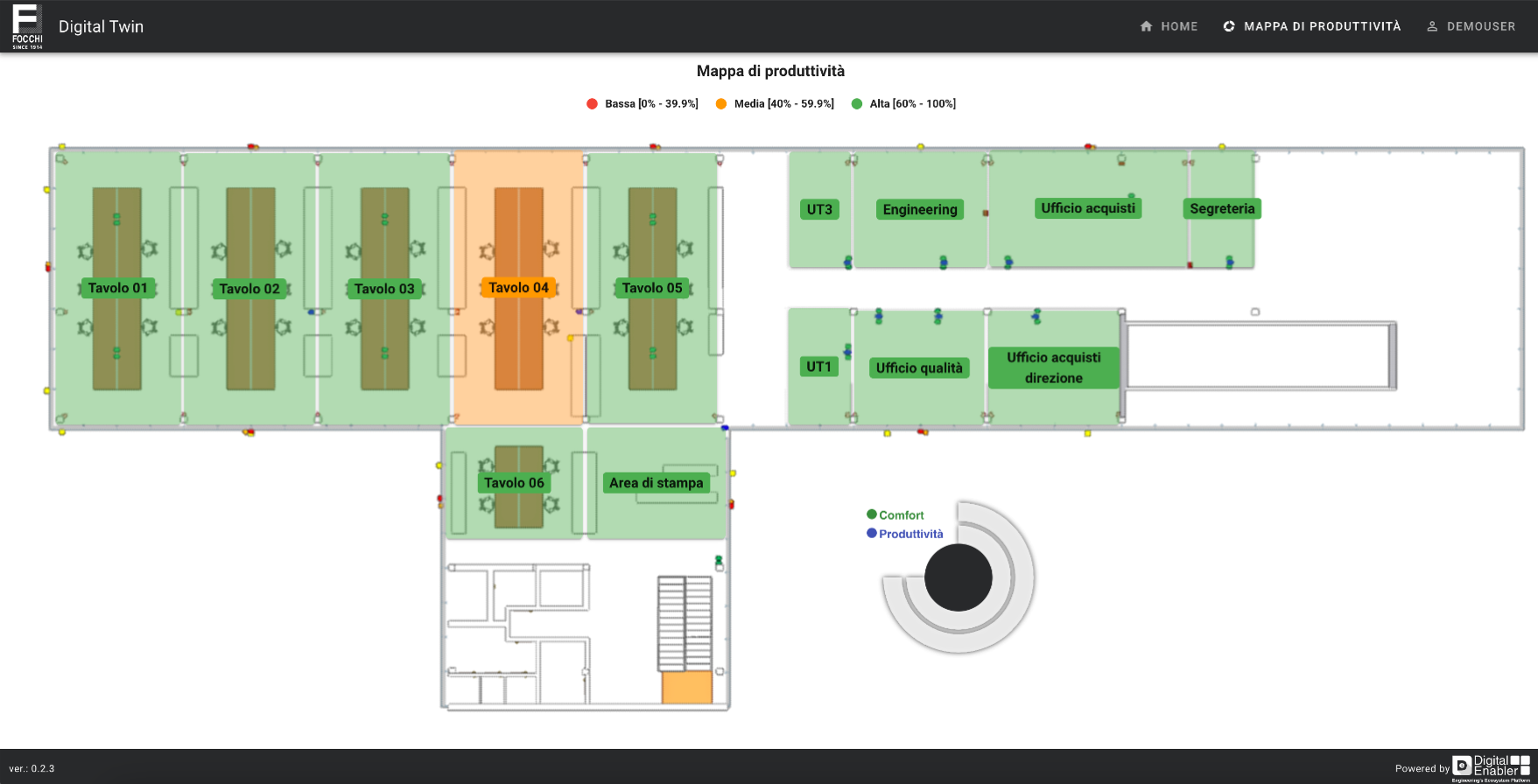Challenge & Context
The evolution of 3D models has been gaining high research attention in several fields, such as aerospace and manufacturing, as well as Architecture, Engineering, and Construction (AEC).
As a next logical step, the Digital Twin concept refers to developing a mirrored digital counterpart to a physical system and linking their information throughout the physical counterpart’s life cycle.
The Digital Twin is expected to augment architectural modelling as a progressive step that develops from Building Information Modelling (BIM) in the AEC field. The use of such Digital Twins would thus contribute in making buildings smarter and in enhancing their sustainability. Linking such a concept to the development of Smart Building means to utilise cyber-physical intelligence to improve building functions, provide more comfortable and safe conditions for people and businesses, and increase overall satisfaction.
XDT (eXtended Digital Twin) aims to improve not only energy efficiency but to define a holistic view of the building: sustainability of logistics, energy consumption, communications, planning, safety, security, internal mobility, liveability.
The engineering Groups, Focchi Group, eFM and Marche Polytechnic University, emphasize the main features of XTD which integrates and augments the following:
- the surveying and mapping technology including static data of the buildings.
- the 3D model, a sort of digital visualization of a physical project of a building;
- the BIM, an intelligent process of 3D modelling that integrates and manages all the information of the physical entity, providing remarkable cost and time savings, reducing errors, improving collaboration;
- the eXtended reality (XR) consisting in a set of IT tools supported in some cases also by AI allowing and enhancing collaborative workflow and supporting decision management during the life cycle of the construction projects;
- the IoT and 5G reflecting the dynamic data of the building;
- the Blockchain technology providing the trust mechanism of transactions, logistics, and human behaviour;
- the collaborative computing allowing efficient real-time responses thanks to 5G;
- the simulation technology helping policy support, planning, and early warning mechanisms.
For creating XTD, a world in which the digital and physical are symbiotically collaborating, it is necessary to develop a holistic view around the building, aimed at achieving the following challenges:
- remove hurdles to data flows, foster digitalisation, use AI and map the physical and digital worlds in a continuously enriching process;
- create computing ecosystems, tackle interoperability problems in the continuum, foster standard adoption and smooth data flow in the continuum.
- guarantee high levels of cybersecurity in the era of the computing continuum and trustworthy service ecosystems.
In the end, XTD was perceived as an opportunity to enhance building operability. This awareness is strictly based on the concept of developing a virtual mirror of the building, in which all the elements that constitute the building are represented on that virtual model.
Solution
Acknowledging today’s market gaps and challenges, it opened the opportunity for FIWARE Platinum Member Engineering Group and some of its partners to jointly build an innovative solution based on the eXtended Digital Twin concept for Smart Building (XTD):
- Engineering Group, as the digital transformation company providing the platform;
- Focchi Group, as builder of the boldest design ambitions for curtain wall;
- eFM, as a supporter of living new experiences in a world engaging space, time and agent inevitably interrelated with the data;
- Università Politecnica delle Marche as scientific leader of the project.
All these companies believe that this solution will contribute to fostering the adoption of Digital Twin technology and thus enhancing the management, operations, and sustainability of the building.
The technical solution proposed for the XDT is based on the Digital Enabler® keeping the following peculiarities on the top:
- an open and highly scalable cloud platform;
- APIs and connectors to integrate heterogeneous data sources (sensors, people feedback, third-party applications);
- predisposition to advanced device management features both on cloud and over the edge;
- algorithms for energy efficiency, level of perceived well-being inside the building and sustainability of the property, as well as deduction of new information from the acquired data;
- dedicated web app for energy managers, HR managers and facility managers for ESG management of the building;
- standard, interoperability, and security by design thanks to the adoption of FIWARE and Smart Data Models.
The main advantage of an XTD over BIM is the interaction between physical reality and the virtual model. In BIM, the model encompasses the physical entity’s geometrical and temporal information, yet it requires manual data insertion for updates due to the lack of linkage between the model and the physical entity, whereas utilizing a digital twin can provide mutual interaction between the two counterparts in real-time.
The use of sensors and the Internet of things (IoT) technologies easily allow a bidirectional transfer of information, updating the virtual model according to the physical counterpart’s live updates. Furthermore, due to the potential of performing simulations on the virtual model, future forecasting and optimization of the physical entity’s performances of the building are achievable, and thus the optimization of the physical counterpart’s performance can be reached.
The XDT developed is a vertical application of the ecosystem platform Digital Enabler®, the Open Source ecosystem platform developed by Engineering and Powered by FIWARE, that accelerates the setup of new smart solutions through the collection, processing, harmonisation, visualisation of data letting the users run actions and collect feedback on the field.
In XDT, the data collection over the edge is performed through a component of the Digital Enabler named IoT Device Manager that has allowed the plug-in of devices installed in the building, provided by different vendors (in the specific use case, vendors are e.g. Schneider and Bticino) also paying attention to the compliance with the edge computing model: a lightweight module is deployed nearby the curtain wall sensors collecting the data from them. Such module supports a plethora of IoT specific protocols, like Modbus, BacNet, MQTT, and many more. The IoT Device Manager embeds all the FIWARE IoT Agents.
Once the data is collected from the edge, the data harmonization is performed using a no-code (i.e. graphical) approach. The Digital Enabler component that is in charge of the data processing and harmonisation is the Data Mashup Editor. This accelerator allows to represent in NGSI-LD format the data gathered and integrated, using Smart Data Models.
Once the data is harmonized in the selected data models, it is analysed both on the edge and on the cloud. The former feature is particularly relevant when a high-speed reaction is required; the latter is more relevant in case of historical analysis, training of AI models and in general more resource-expensive activities. In fact, starting from environmental data gathered from the field (e.g., temperature, humidity, indoor pollution, irradiance), the solution is able to deduce information about indoor comfort and people productivity and show the data in the building Digital Twin, applying algorithms based on Artificial Intelligence.
The XDT based on the Digital Enabler® platform has been deployed in the headquarters of Focchi in Poggio Torriana (Rimini, Italy), the pilot site depicted in the following picture.
Figure 1 . Focchi Building
How it works
The Digital Enabler® allows users to harmonize, synchronize, integrate, visualize, mashup, federate, and analyse data to deliver their digital transformation vision. In addition, it provides a single point of data knowledge and access that can be used to develop new value-added services as well as digitally enabling older technologies and applications:
- data discovery: identify potential data sources within an ecosystem;
- data collection: collect insightful data and make it easily exploitable via the platform;
- data integration: mash-up multi-source data to create new knowledge;
- data harmonization: harmonize data to FIWARE Smart data Modela;
- data visualization: visualize data through intuitive and replicable dashboards.
The overall architecture of the Digital Enabler is depicted in the following chart, where the yellow boxes are the components of the ecosystem platform which have been used for XDT:
Figure 2 . Architecture 1
The XDT allows to gather, elaborate, process and to harmonise the incoming data in real time through several components like the IoT Device Manager, Data Mashup Editor, Dataflow, ClouDev, or AI Studio:
-
- IoT Device Manager: it is used to connect “push” and “pull” devices (both sensors and actuators), orchestrate different device hubs allowing the definition of use cases with devices managed by multiple device management platforms (such as AWS, Azure, etc), define and run simulation scenarios, define rules to trigger alarms for early warning, anomaly detection and predictive maintenance;
- Data Mashup Editor: is a no-code component that, through the usage of a predefined palette of draggable operators, helps the data modeler in defining real-time data transformation and harmonisation processes;
- Dataflow: is a low-code component, based on Apache technologies, that makes the definition of batch ETL processes easier to define thanks to the usage of simple python-based flow descriptors;
- dlouDev: is a serverless environment where a programmer can define the data processing and elaboration logics through the definition of functions in python, java, ruby, javascript and many other programming languages, without the need to take care about the deployment and the server management;
- AI Studio: is the operations and algorithms catalogue as a service for data scientists. It allows to make predictions, to perform trends analysis and early warnings upon time series data and to publish algorithms as a service. In the context of XDT, AI Studio accelerates the development of AI algorithms, for example to deduce the level of comfort and productivity inside the building.
The data, as they are processed and harmonised, are visualised on a tri-dimensional representation of the curtain wall. The final visualisation is done putting together the 3D model of the entire facade submitted in IFC format and the harmonised data.
Figure 3 . Architecture 2
The XDT allows to have real time insights about curtain wall performances to support building energy efficiency and user comfort expectations as well as support activities for ´Facade Operation & Management enabling new business models (e.g. ESCO).
The XDT will interoperate with the Building Digital Twin Environment platform through Smart Data Models about Curtain Wall. Several fields sensors have been user and installed provided by different producers, for the detection of:
- ambient and surface temperature;
- weather station;
- CO2 concentration;
- noise level;
- brightness;
- gateway of systems for the generation of green energy (solar panels, etc.).
Furthermore, there are many actuation devices on site for:
- gandling of opaque covers (curtains, blinds);
- HVAC management systems;
- window handling;
- dimming artificial lighting.
Figure 4 . Devices data gathering through the IoT Device Manager
Figure 5 . Data harmonization through the Data Mashup Editor
Figure 6 . Deduction of information about comfort and productivity using AI
Benefits & Impact
The main benefits and values of XDT lay within its own name: a digital copy of reality, where “seeing”, “thinking” and “acting” is possible in a totally risk-free environment.
XDT being a very powerful application, it brings a set of benefits:
- continuous improvement: implementation of XDT concept encompasses many other digital technologies and innovations which in turn can lay the necessary foundation, whether knowhow or infrastructure, for future business improvements;
- predictive: using various modelling techniques (simulation-based, mathematics or data-based modelling) the XDT model can be used to predict the future state of the building;
- what-if analysis: through properly designed interfaces, it is easy to interact with the XDT and simulate different scenarios to identify the best actions to be then applied on the physical twin.
- visibility: XDT enables visibility and transparency in the operations of the building as a complex interconnected system;
- Iinsight: XDT can be used as a communication and documentation mechanism to understand as well as explain the behaviours of the building as a whole;
- system Integration: XDT can be used to connect the backend business applications to achieve business outcomes in the context of supply chain operations including manufacturing, procurement, warehousing, transportation and logistics, field service;
- disruptive business models: XDT not only boosts the domain-traditional business models and value chains but also expands them by developing new value creation mechanisms via data-driven or product-as-a-service business models. These are delivered into an ecosystem that attempts to reach new customers and other partners to exploit new revenue streams and opportunities.
In order to maximise the impact, we need to consider the following objectives:
- optimize the level of productivity of employees through the optimization of the level of environmental comfort;
- stimulate common awareness on environmental issues starting from greater awareness and a reduction of emissions attributable to the buildings;
- exploit benchmarks to identify social and environmental interventions that could be implemented to achieve (or at least aspire to) carbon neutrality;
- transparency of building management (including the public real estate) even achievable through the publication of data collected in the form of Open Data (carbon footprint and ESG goals).
XDT solution will be used by several identified actors:
- Facility/Energy Manager: person in charge of supervising and managing the energy performance indicators of one or more buildings. This person has access to the monitoring dashboard and the administration and configuration application;
- Human Resources Manager: part of the client’s HR department. This user can be in charge of managing the challenges, defining the prizes and feeding the application called People Engagement App;
- Company population: set of users who, through the People Engagement App can participate in the challenges and other initiatives launched by the HR manager;
third-party systems: systems of partners/customers with whom XDT may/must interoperate.
Added value through FIWARE
The solution is entirely based on open standards and open APIs, and Smart Data Modela models, according to FIWARE Foundation and Open and Agile Smart Cities (OASC) principles. It is part of the category ‘Powered by FIWARE’ in the FIWARE Marketplace.
By using FIWARE NGSI APIs, which easily enable the integration of different components and systems, Engineering ensures that the platform is interoperable, portable, and can be easily implemented in other neighbouring regions and nations, as well as on a global scale.
As the Digital Enabler® is an ecosystem platform which, thanks to its characteristics, it can be applied in a multitude of domains and situations like in the Health sector with DE4Bios, a biosurveillance platform, which has been enabling the monitoring of the evolution of COVID-19 epidemics since its very beginning. This means that not only can this cloud-based platform be connected with other applications or pieces of software already widely available, but it can also be replicated to serve various other purposes at a fast speed and with lower costs.
Another benefit sits with the Context Broker, the FIWARE Generic Enabler, which is a software component that can integrate data from multiple systems, creating a holistic view of contextualized information, and acting as the center of the system. By providing the layer that describes each type of data, the FIWARE Context Broker makes it possible to create an interface proving it easy for anyone to view and interpret data.
The Context Broker uses FIWARE NGSI v2 specifications that enable applications to provide real-time updates and access to information that contextualizes the data being displayed. Typical examples might include updates, queries, and notifications. This way, organizations can monitor their metrics in real-time through live updates. Context information can be shared with third parties enabling process improvements and innovation across the whole data value chain.
References
Authors & Contributors


